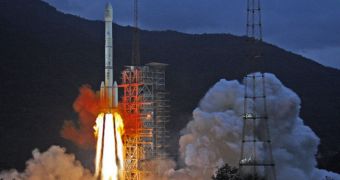Late yesterday night, the Chinese National Space Administration (CNSA) launched their second robotic probe headed for the Moon. The mission is part of the country's ambitious efforts to become a power in space as well.
The spacecraft took off on October 1, at 1059 GMT (6:59 EDT), from the Xichang Space Center, in the Sichuan province of southwestern China. The probe is called Chang'e 2, and is the precursor of the first Chang'e mission.
With the new launch, China marks a new stage in its space exploration plans, which are more ambitious than any country's today. They include putting men on the Moon, and building a space station.
The idea about building a new orbital facility came after the first successful spacewalks and manned launches. Officials with CNSA believe that a space station is possible if a demonstration flight later this year is successful.
But those plans are still a few years away. Right now, the Chang'e 2 mission is the most important that the Chinese are conducting. It was prompted by the success of the first flight.
Over the past decade or so, the Asian nation has begun taking a very active interest in low-Earth orbit and the Moon, and has announced plans to build its own space station and lunar exploration robots.
Chang'e 2 represents the second of the Chiense lunar exploration program. Current plans call for Chang'e-3 to land on the Moon by no later than 2013, Space reports.
Chinese officials are convinced that the plan is entirely feasible. “It is estimated Chang'e-2 can reach lunar orbit within five days, compared to 13 days, 14 hours and 19 minutes for Chang'e-1,” told Xinhua expert Ouyang Ziyuan.
He is the chief scientist of the China Lunar Exploration Project, which runs Chang'e. The expert reminds that the first lunar orbiter conducted a successful 16-month flight above the Moon, from October 2007 to March 2009.
Xinhua reports that the newly-launched spacecraft will at the end of its mission descend to lower altitudes above the Moon, of just 9 miles or 15 kilometers.
From this vantage point, high-resolution cameras on the probe will collect detailed images of prospective landing site for the Chang'e 3 spacecraft.
This approach is similar to the one NASA uses. The Lunar Reconnaissance Orbiter (LRO) has been sent around the Moon last year to map the natural satellite, in search for landing spots suited for future exploration missions.

 14 DAY TRIAL //
14 DAY TRIAL //